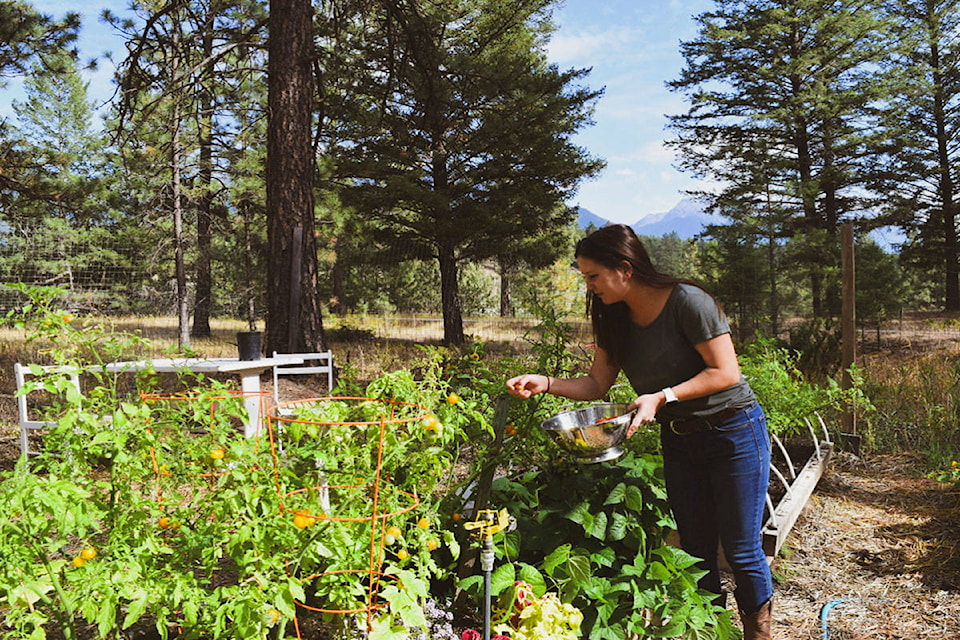The is sun shining down on me, speckling my face through the brim of my hat. My hands are filthy, dirt crusted under my finger nails. I inspect each and every plant in my garden, tending to their needs, picking tomatoes, zucchini and beans. Deadheading spent flowers. I pluck carrots from the earth, carefully digging around their roots so their greens don’t break off. We’ll use those too.
A giant grasshopper sits atop my last remaining dahlia. I shoo him away. That’s my flower, sir. I notice the abundance of bees buzzing around my sunflower patch, I watch them closely as they pull seeds from the centre and suck out the pollen. A few of them carry on to the squash and zucchini plants. Moths flutter impetuously atop the marigolds. The garden is still very much alive and well.
I’ve learned so much over the past seven months of gardening. This year I put so much effort into my garden and it shows. I am proud of how far it has come. We started with a mound of weeds and pine needles and now have colourful a little oasis just steps from the front door. An oasis of nourishment for our body and minds. An oasis for all of the pollinators that we so desperately need. A place I can come home to. A place I can feel accomplished, calm and inspired.
I started research for my garden back in January. I wanted to know how to make my soil healthy. I wanted to figure out how to grow the most amount of plants in a fairly small area. I wanted to know how to extend my growing season as much as possible. After many hours of reading books and online articles I answered these questions and more.
A soil test showed that our sandy soil was low in potash (potassium) and nitrogen. A good helping of compost and well aged manure to the rescue.
We started with hoop houses, planting seeds directly into the soil and also transplanting some we had started inside. Radish, kale, beets, spinach and cabbage thrived in these hoop houses the early months of spring.
We built potato boxes and learned that as we were adding more soil and more boards, we should have also been adding more tubers. We didn’t end up getting a giant harvest from the potatoes, but the ones we did grow are simply perfect.
As summer rolled in, the cooler crops began to struggle, but the stars of summer took off. When our first little green tomato sprouted I exclaimed with joy, jumping around like a child. I won’t forget that feeling.
In the heat of summer I also started to experience issues with a few pests, and watering in the evening was awful during our lengthy mosquito season. I recall one night when it was still 28 degrees outside but I had to wear pants, socks, boots, a hoodie and a mosquito net around my head to water. Even with Muskol (the king of all bug sprays) I still got eaten alive.
We remedied the mosquito issue by setting up an irrigation system. Our garden is watered on a timer twice a day. Next year, I plan on installing drip lines. This will ensure the soil gets a good soaking and therefore the root systems do too. The sprinkler does a good job, but watering from the top is not ideal.
The other pest issues we experienced were minimal, but the two we had troubles with are ruthless: cabbage worms and earwigs. I ended up ordering some BTK from Top Crop and it worked really well in combating the cabbage worms. My cabbage is still growing and looks absolutely delicious. We buried a few cans of non-alcoholic beer down into the soil and the earwigs went straight for them. They are still around, but few and far between in comparison.
I know many people in the area have already experienced frost, and touch wood, we’ve been lucky so far. Gardens depend on weather and when the weather is unpredictable, there’s not much you can do. You can tuck your plants under sheets or plastic and hope for the best.
I’m thankful for all of the resources out there, from old books passed down by friends and family to Facebook groups like ‘Farm the Kootenays’. Even many readers of this column have reached out with advice or questions.
As I begin our final harvests, planting our fall crops and thinking about next year’s garden I’m filled with glee. I find relief in knowing that next year’s garden will be even better because I can take the lessons learned from this year and apply them.
2020 has been a rollercoaster but my garden has been one of the many things keeping me sane, motivated and positive. It may sound silly, but my garden has been my friend through it all. I’ve laughed, cried (mosquitoes), had sore muscles, laid in the dirt, enjoyed many a meal and spent some real quality time with my significant other. Gardening has so many more benefits aside from feeding us. It has connected me with myself and the earth. I think I can now officially say that I have a green thumb.
